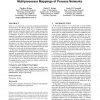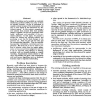529 search results - page 88 / 106 » A framework for the description of evolutionary algorithms |
ICCS
2009
Springer
14 years 2 months ago
2009
Springer
Abstract. In knowledge bases, the open world assumption and the ability to express variables may lead to an answer redundancy problem. This problem occurs when the returned answers...
KDD
2006
ACM
14 years 8 months ago
2006
ACM
How do we find a natural clustering of a real world point set, which contains an unknown number of clusters with different shapes, and which may be contaminated by noise? Most clu...
CODES
2003
IEEE
14 years 25 days ago
2003
IEEE
In the Sesame framework, we develop a modeling and simulation environment for the efficient design space exploration of heterogeneous embedded systems. Since Sesame recognizes se...
AAAI
1994
13 years 8 months ago
1994
Many AI problems can be modeled as constraint satisfaction problems (CSP), but many of them are actually dynamic: the set of constraints to consider evolves because of the environ...
JCB
2006
13 years 7 months ago
2006
We propose a dictionary model for haplotypes. According to the model, a haplotype is constructed by randomly concatenating haplotype segments from a given dictionary of segments. ...


